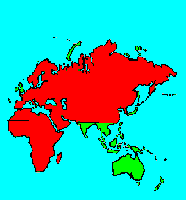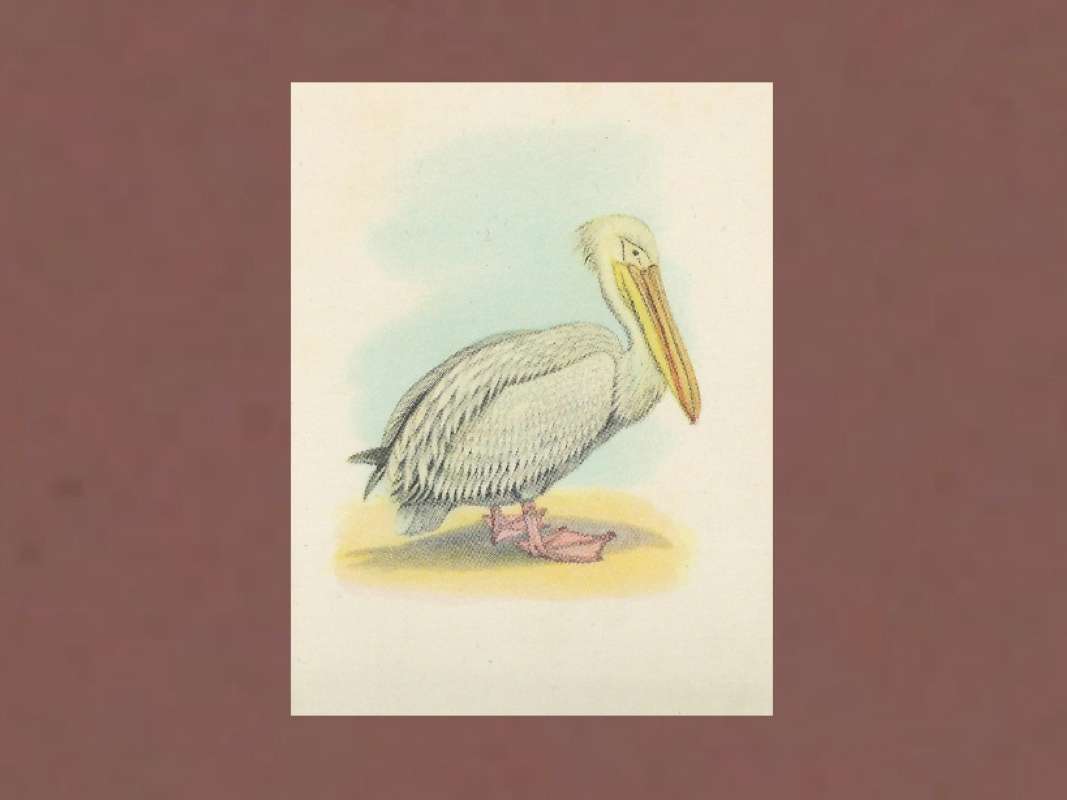SPECIES INFO
Old World White Pelican (Pelecanus onocrotalus) is found from Europe to Africa to the Orient. Its range is now reduced, and in the European region it is found primarily in the lower Danube region and the northern Caspian Sea region. It is found in several disjointed areas in Africa. It is still probably found in northern India. This is a very large bird, being up to sixty-five inches in length. When flying the underside of the outer wings shows a broad dark band. (In Pelecanus crispus this band does not exist, but only dark tipped feathers show when flying.)Pelicans genus (Pelecanus) are found widely in the world. There are 8 species. (At least 10 additional fossil species are known.) Most pelicans are large white birds, but the northern New World species is brownish. These can reach large sizes. The New World brown pelican can have a wingspread of 6.5 feet, but some of the white species can have wing spreads over 9 feet.
These birds have unusual methods of feeding. Some species form groups and herd fish towards shores. The brown pelican flies above the water and then makes a dive for fish. Pelicans have large pouches that can hold large amounts of water. They use their beaks to place large amounts of water into these pouches and then eliminate the water and swallow the remaining fish. When flying these birds frequently cock their long neck back over their body.
Pelican group (Family Pelecanidae) are a group of ancient birds that have expandable pouches under the lower bill. There are only eight species of Pelicans found in the world. List of Known Pelicans (Alphabetical sequence)
Pelecanus conspiculatus - Australia Pelican - Australia
Pelecanus crispus - Dalmation Pelican - Orient
Pelecanus erythrorhynchus Amer. White Pelican - W North America
Pelecanus occidentalis - Brown Pelican - New World
Pelecanus onocrotalus - E. White Pelican - Eurasia & Africa
Pelecanus philippensis - Gray Pelican - Orient
Pelecanus roseus - W. White Pelican - Orient
Pelecanus rufescens - Pink Back Pelican - Africa
Pelicans and Allies (Order Pelecaniformes) contains six different families of marine birds. Most are large species and
most feed on fish. One distinguishing feature of this order is the webbing that connects all four toes.
Aves contains about 8,650 different species of living birds known to science. Each year about one new species is discovered in some remote rain forest or remote island. In addition, scientists have been raising many subspecies to full species status which may raise the species count to 10,000. Birdlife recognizes 10,027 species as of 2011.
However, each year about one species goes extinct. The rate of extinction is increasing, and the rate of new discovery is decreasing, so that the number of bird species will soon begin to decline rapidly. Although different taxonomists would organize the birds differently, there are approximately twenty-seven orders of birds. These orders are broken down into about one hundred and fifty-five different families.
Recent research of the genetic structure of some of the shore birds and owls would indicate that the present organization of orders and families should have some modification.
The birds are a worldwide group of animals that are characterized by having the front limbs modified into wings that are used for flying. Perhaps the most unique feature of the birds is the feathers. These feathers are made up of a central support called a quill and a series of small filaments that are hooked together as barbs.
For many years it was believed that Archaeopteryx discovered in Bavaria was the oldest bird from about 150 million years ago. However, in l986, Sankar Chattterjee, a Texas paleontologist, reportedly discovered a bird in the genus Protoavis that lived about 225 million years ago.
When this project was begun in 1978, we used Austin & Singer for bird taxonomy. Since then, we have adopted many changes, but have kept some older concepts that are still found widely in the literature. Recently, we have used Clements and Howard & Moore. Very recently, we have used Monroe and Sibley for the higher taxonomy of the perching birds.
Backboned Animals (Phylum Chordata) are the most advanced group of animals on earth. These animals are characterized by having a spinal cord or backbone. Most members have a clearly defined brain that controls the organism through a spinal cord. Fish, amphibians, reptiles, birds, and mammals are in this phylum.
Currently, some taxonomists believe that the fish should be divided into two groups (sharks and regular fishes) and that there are some other primitive groups in the phylum such as hagfish or lampreys.
Animal Kingdom contains numerous organisms that feed on other animals or plants. Included in the animal kingdom are the lower marine invertebrates such as sponges and corals, the jointed legged animals such as insects and spiders, and the backboned animals such as fish, amphibians, reptiles, birds, and mammals.




